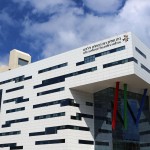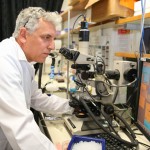Israeli Researchers Unravel Mysteries of Parkinson’s Disease
Jerusalem, 5 March, 2024 (TPS) -- Israeli scientists established a crucial connection between Parkinson’s disease and a network of molecules surrounding the brain, opening new avenues of research to better understand the disorder and develop targeted therapies.
Parkinson’s disease is a progressive neurodegenerative disorder that primarily affects movement. It develops gradually, often starting with mild tremors in one hand. As the disease progresses, movement symptoms can worsen and may include stiffness, slowness of movement, and difficulty with balance and coordination. Other symptoms may include changes in speech, writing, and facial expressions, as well as cognitive impairments, mood changes, and sleep disturbances.
The exact cause of Parkinson’s isn’t clear, but both genetic and environmental factors are believed to play a role. There is no cure, so current treatment focuses on managing the symptoms with medication, occupational or speech therapy, and in some cases, deep brain stimulation.
A research team from the University of Haifa led by Professor Shani Stern, delved into the intricate molecular processes occurring within the brains of Parkinson’s patients. Its findings were recently published in the peer-reviewed journal, npj Parkinson’s Disease.
The team specifically focused on the extracellular matrix (ECM), a complex network of molecules that surrounds and supports brain cells. This network plays a critical role in maintaining the structural integrity of the brain. It also regulates intercellular communications. Disruptions in the ECM composition or function have been implicated in various neurological disorders, including Alzheimer’s disease, epilepsy, and traumatic brain injury.
Parkinson’s disease, characterized by the progressive degeneration of dopamine-producing cells in the substantia nigra region of the brain, has long been a subject of intense scientific scrutiny. However, the majority of research efforts have concentrated on genetic factors, which account for only a small fraction of cases. The Haifa University researchers sought to bridge this gap by exploring the role of the extracellular matrix in both genetically linked and sporadic instances of Parkinson’s disease.
Utilizing innovative techniques such as cell reprogramming, the researchers obtained skin cell samples from Parkinson’s patients with known genetic mutations, as well as from those with no identifiable genetic predisposition. By transforming these cells into stem cells and differentiating them into dopaminergic neurons, the team recreated a cellular model reflective of Parkinson’s pathology.
The results were striking.
Across both groups of patients, the study identified significant alterations in the expression of genes responsible for extracellular matrix proteins. Specifically, diminished levels of mRNA and protein components associated with the extracellular matrix were observed in cells derived from Parkinson’s patients compared to healthy controls.
Moreover, the study uncovered a novel finding: the aggregation of collagen 4 protein, a critical building block of the extracellular matrix, exclusively in Parkinson’s patients. These aberrant changes in the extracellular matrix coincided with decreased synaptic activity and impaired neuronal communication, shedding light on the underlying mechanisms driving Parkinson’s disease progression.
The researchers believe their findings will eventually lead to the development of targeted therapies.







